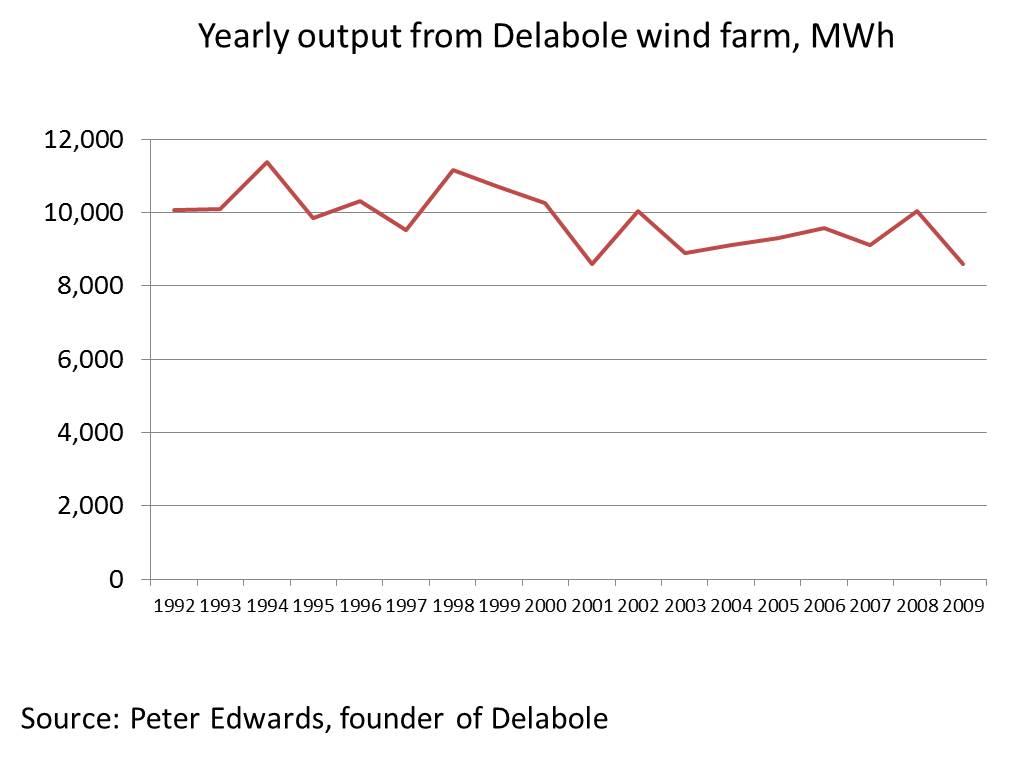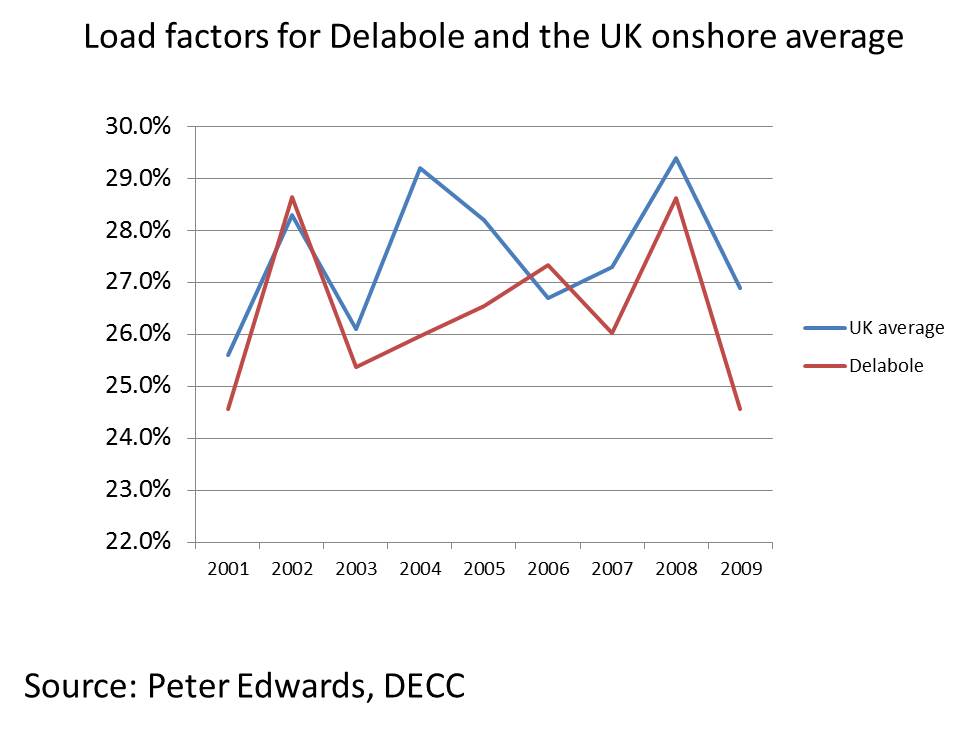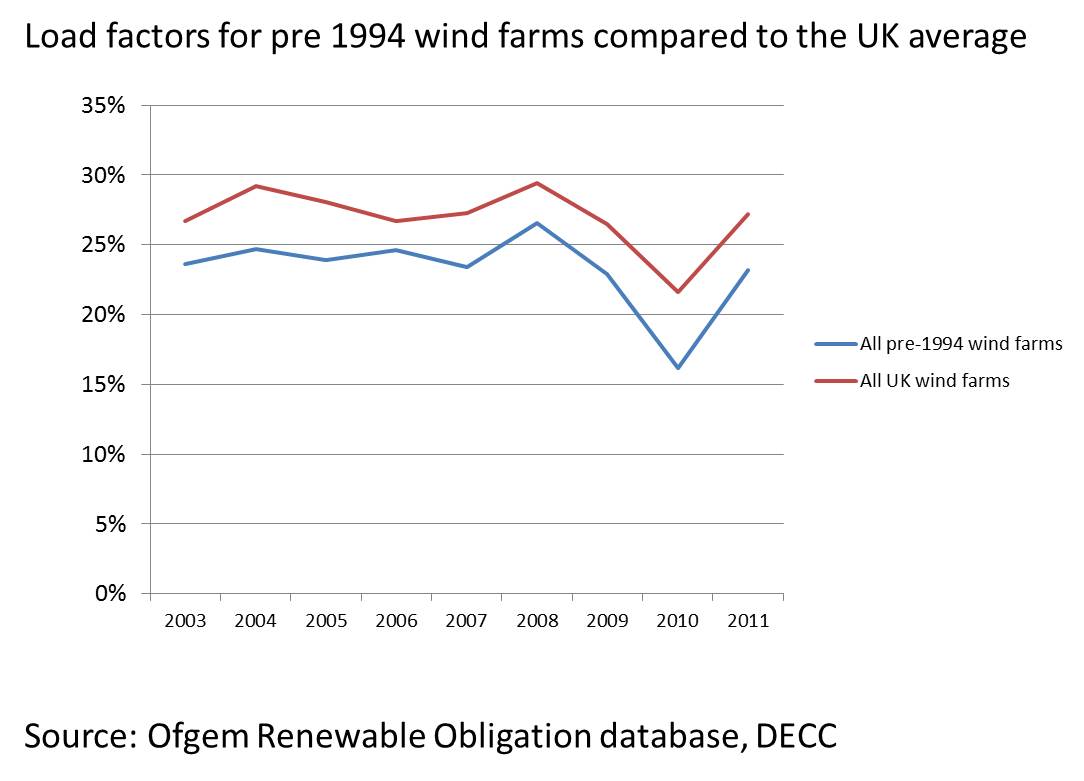Electricity output figures show wind turbine performance deteriorates very slowly with age
I wrote a few weeks ago about the surprising assertion from the Renewable Energy Foundation (REF) that the performance of wind farms declines rapidly with age. A study carried out by Professor Gordon Hughes for the REF in 2012 suggested that ‘The normalised load factor for UK onshore wind farms declines from a peak of about 24% at age 1 to 15% at age 10 and 11% at age 15’. To put this in everyday English, Professor Hughes is saying that a 15 year old onshore wind farm will typically produce less than half its initial output of electricity. Few people in the industry would demur from a conclusion that wind farms very gradually lose output but none accepted Hughes’s finding that electricity generation falls at anything like the rate he stated. If true, his finding would have serious implications, as the REF was keen to point out. To achieve the UK’s targets for wind-generated electricity, we would have to put more turbines on the ground because ageing wind farms would produce much less power than expected. This is an important topic and I thought it needed more examination.
After meeting REF in early 2013, DECC Chief Scientist David MacKay responded to the study, eventually publicly saying that Hughes’ work had serious statistical flaws. REF has recently rebutted Professor MacKay’s comments saying, with some asperity, that his actions are ‘extraordinary’ and impugning his understanding of econometrics.
Few of us have the detailed knowledge of statistics to say whether Hughes’ conclusions follow from the data he has used. I thought it might therefore be helpful if I analysed the individual performance of all the UK’s oldest wind farms. I’ve looked at the data on the output of 14 farms, all established in the period 1991 to 1993. I’ve been particularly helped by the assistance of Peter Edwards, the entrepreneur behind Delabole, the Cornish wind farm that started the UK’s commercial exploitation of wind for the purpose of generating electricity in December 1991.
Hughes’ study contained no assessment of the performance of specific wind farms. All the data was merged into one large statistical series. On the basis of my assessment of actual production data from the earliest farms – all but two of which are still operating with the initial turbines – I want to suggest that the empirical evidence strongly suggests that Professor Hughes greatly exaggerates the rate of performance decline. None of the 14 wind farms shows ageing effects more than a small fraction of the figures he quotes. Investors and the general public can be confident that performance degradation is not a large problem.
Method
I have two sources of data. First – with many thanks to Peter Edwards – I have the yearly output figures from Delabole from 1992 until the farm was ‘repowered’ with new, much larger, turbines in mid 2010 after nearly twenty years of production.
Second, I have the numbers from Ofgem’s database on the output of renewable generators. These numbers only go back to April 2002. (I have no idea how Professor Hughes could possibly have calculated the rates of decline of electricity output of twenty year old turbines when – at most – he only had ten years of figures).
We also have information on the average performance of UK onshore commercial wind turbines. DECC publishes a yearly estimate of the ‘load factor’ of existing wind farms. (The ‘load factor’ is the percentage of maximum yearly output actually achieved). Load factors vary – principally in response to average wind speeds. Professor Hughes’ work suggests that after accounting for wind speed variations load factors fall every year from the moment a new turbine is installed. This is what I wanted to check using real world data.
Delabole
Chart 1 shows the yearly output from this Cornish wind farm from 1992 to 2009. (The repowering process started in mid 2010 so later output figures are not available).
Peter Edwards commented to me that the reason the 2009 figures appear to show a drop is that the operators of the wind farm (by then it was the utility Good Energy) decided it wasn’t worth replacing a gearbox because the turbines were scheduled to be taken down in less than a year’s time.
But even with the lower level of output in 2009, the average yearly decline was only about 0.8% of output, not the 5% estimated by Professor Hughes. [1]2009 electricity production from turbines that were then 18 years old was 85% of the first year’s figure. In 2008 – when the turbines were still being actively repaired – Delabole recorded electricity generation of 99.6% of its initial annual output. Rather than output being more than halved, performance had fallen by a few megawatt hours a year.
Chart 1
I don’t have UK average ‘load factors’ before 2001. Chart 2 shows how Delabole compared to the typical onshore wind farm in the years between 2001 and 2009. On average it was slightly lower, with a more marked difference in 2009 because of the lack of repairs to gearboxes. But the differences are small and there certainly isn’t any obvious sign that the performance was degrading against the UK average.
Chart 2
The oldest UK wind farms
If Hughes is right, then the oldest turbines should be very much less productive than the average UK figures. Of course wind farms established in the early 1990s might have been placed in particularly wind locations which might push their outputs upward. Balancing this, newer wind turbines could be expected to be better designed, and able to turn more of the energy from wind into useful electricity.
Chart 3 shows that the 14 oldest wind farms have load factors slightly below the UK average for the years 2001 to 2011. But there is no evidence of any widening of the differences. And, most importantly, the absolute level of output of these geriatric turbines is very much higher than Professor Hughes said. He wrote that turbines in their fifteenth year of operation should typically produce 11% load factors. In fact, these elderly wind farms – all of which were over eighteen years old in 2011 – had average load factors of well over twice Hughes’ predicted output. They seem to have suffered more than expected in the historically highly unusual low wind speed year of 2010. (I suspect this is a consequence of better engineering for low air flows in newer turbine designs). But otherwise performance shows no relative decline from a decade ago.
Chart 3
One last request. Anybody in active communication with Professor Hughes might want to ask him two questions. First, can he show us any individual wind farms that demonstrate the rate of deterioration his forecasts suggest? There were about 380 onshore wind farms recorded in 2012. The oldest 14 show nothing like the signs of ageing that Hughes grimly forecasts. Do any others? Are there any examples of farms whose wind-speed adjusted output has actually fallen 5% a year as he predicts?
Second, given that the outputs from wind farms are only publicly available from 2002, how is the Professor able to estimate exactly what the rate of decline in output of a twenty year wind farm is likely to have been? Because of Peter Edwards’ generosity in releasing Delabole figures to me, I can show that the decline of that single farm’s output is nothing like Hughes’s statistical forecasts. How did the Professor get to his numbers when he only had – at most – ten year’s data available for all the rest of the UK’s fleet of turbines?
[1] This is estimated using simple linear regression.
[2] These calculations exclude Delabole and Goonhilly wind farms for the years after mid 2010, when both were repowered with new turbines. The other farms have unchanged configurations. The load factor I have used for the UK as a whole is also on an 'unchanged configuration' basis.


